
Spring in Bill Oddie's Garden: A Peek into Seasonal Changes
Share
I am sure we all consider it a privilege and a pleasure when we put food out in the garden and are able to watch the birds arrive, sample the wares and then become ‘regulars’. We also have the satisfaction of knowing that we really are helping them to stay healthy and survive.

In return, we enjoy their habits, antics and occasional squabbles at the feeders. We may even get to know certain individuals or -better still- pairs. Best of all, is when they actually decide to nest and successfully rear youngsters. It is also a terrific opportunity to observe the various stages of the ‘mating game.’
It may not be long past Christmas when you notice that there seem to be a few extra male Blackbirds on the lawn. What’s more, they seem to be spending less time pulling up worms, and more chasing one another, until one is declared the winner, which qualifies him chase a female instead. The same sort of thing is going on with the Robins, only their fights and flights are even more high speed and ferocious. With Robins, it’s not so easy to sort out who is who because both sexes look the same. And just to cause further confusion, both sing, though the male’s tunes are rather more forceful.
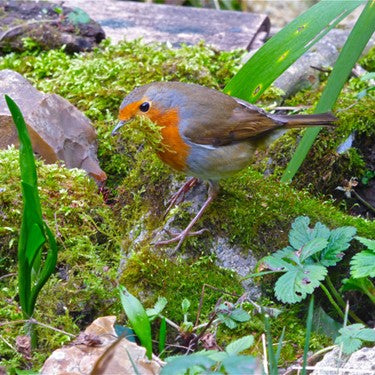
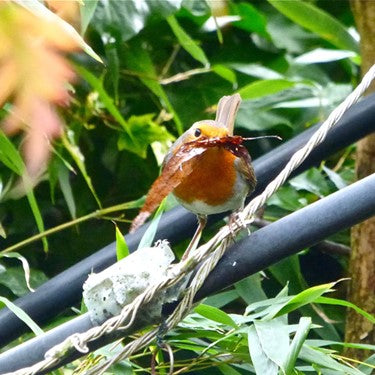
Often the first clue that a pair of any species has started building a nest is when you notice them carrying nesting material. Several times this spring, my Robins looked as if they were sporting large droopy moustaches. They were actually collecting leaves that had fallen off the willow tree. I was able to sit at the garden table -with a cuppa in one hand and my camera in the other- whilst both male and female came and went. They followed a routine of perching on a fence , then onto a trellis -where they’d pause a while no doubt waiting till they felt it was safe- whereupon they dived into the thick Ivy that has long swallowed the pipe into my water butt. They’d be out sight for only ten or twenty seconds, before they popped out now moustache-less, and perched briefly on a nearby bare branch before setting out again on their leaf collecting round.
After a few days, I noticed that they had switched from leaf gathering to plucking moss from the rocks by one of my little ponds. This told me that they were now working on the lining. Moss is much cosier to sit on than soggy willow leaves, both for the parents and the chicks. The nest making took just about a week of pretty non stop activity.
The next stage was egg laying, which was of course an entirely private matter. Occasionally, a bird will nest below a window and you can look down and see the eggs but that really only applies to classic “cup shaped” nests like blackbirds, thrushes or pigeons. Robins hide their nest somewhere you can’t look and really shouldn’t feel. What I did notice was that very occasionally both birds would be visible on the nearby fence, where they indulged in a little mutual affection and encouragement. The female trembled her wings in the manner of a youngster, begging for food, and the male fed her a mealworm.
One morning another week later, I realised that the eggs had hatched. Both parents were belting back and forth, usually carrying a mealworm –courtesy of me- or a small fly –courtesy of their sharp eyes. After four or five days of this I had a vision of three or four tiny reptilian chicks beginning to get bigger and sprout feathers. Already I was concerned that when they finally left the nest they would be pounced on by a lurking predator. I should have worried sooner.
I was away for 4 days. On returning, as always , I went out into the garden. I was immediately concerned. No Robin flitted in to greet me. I stared up at the Ivy. No cheeping, no rustle. Five minutes later, a single bird landed on the table grabbed a stray sunflower seed and flew away next door. After a short while, I was convinced that the nest had been robbed. I got a ladder and parted the leaves to reveal what was left of the Robin’s hard work. The nest hadn’t been totally ransacked but it was a bit of a mess. Sadly though, there were no chicks, or no eggs. And no young Robins this year? Not necessarily. Like many small birds Robins often have two if not three broods. Last year a couple of fledglings took refuge in my shed in early autumn.
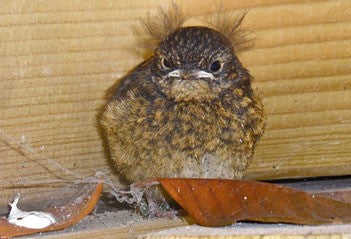
Who dunnit? Several suspects: Grey Squirrel, a Rat, Magpie or Jay. For once I don’t think I can blame next door’s cat! Meanwhile, note to self, if they do build a second nest, enclose it in a large “chicken wire” box with mesh big enough to let in a bird but not a burglar. Seriously, I did that a few years ago and the parents simply stood aside as if muttering, “nice idea, but get on with it”. They came and went immediately, and the chicks were safe. The basic rule is that once eggs have hatched, it takes more than a “safety cage” to cause the adults to desert. In fact ,I’d like to think they are grateful.
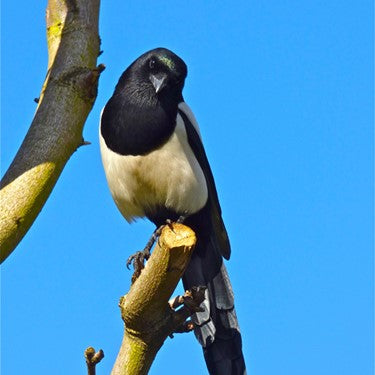
Robins aren’t the only species that regularly nest in my garden. I have put up a number of nest boxes -and so should we all- but I admit that birds are often a bit perverse about using them. Blue Tits and Great Tits are most likely to go for an “artificial” home, though they will also favour holes and crevices in walls and sheds, or even pipes and chimneys. Wrens also like tit boxes, which they cram with a ball of moss and leaves. Robins will use open fronted Robin boxes, but do hide them away in thick cover . Both Blackbirds and Song Thrushes build a “traditional “ bowl shaped nest, largely out of dry grass. The Blackbird’s is also lined with grass, but the Song Thrush adds a lining of mud so smooth that a master plasterer would be proud of it. Dunnocks hide their mossy bowl in a thick hedge.
Desirable residences.
Persuading birds to nest in your garden.
Put up nest boxes. Site them so that they are not baked by the sun. Different sized holes accommodate all sorts from Blue Tits to Great Spotted Woodpeckers. Unfortunately some, Great Spotteds will hammer a Blue Tits nest hole until it is big enough to stick its beak in and steal the chicks.
Open fronted next boxes are often used by Robins -and often not! - and Spotted Flycatchers if you are lucky.
By all means try any of the custom built bird homes – including artificial Swallows and House Martin nests – but I always feel it is most satisfying to make sure your garden offers plenty of “natural” locations. This may often mean leaving things a bit messy. Wildlife gardening often does! Cracks and holes in old stone walls, roofs and eaves. A dilapidated shed with a cracked window, thick shrubs and bushes and of course Ivy. Please don’t clear it all.
More Mouths to Feed.
I still get asked: “Should I feed the birds in Summer”? Yes, yes and yes again. For a start, parents birds have to find food both for themselves and their young. Providing it for them helps them save time, and increases energy. Don’t be concerned that the babies may choke on inappropriate food. Avoid whole peanuts by all means, but chances are parent birds know what to and what not to give their offspring. They will be grateful for a supply of the kind of soft foods that “echo” nature’s produce and mealworms are always welcome, at any time of the year.
Tatty Tits!
As summer wears on, chances are that many of the birds in your garden will begin to look a bit worse for wear, maybe a lot worse. Some of them go bald, others lose their tails, or get gaps in their wings. There are two factors involved. Hole nesters in particular rough up and break feathers every time they squeeze in and out of the nest box. Moreover, their faces are constantly pecked by hungry youngsters. By the time the chicks fledge, mum and dad are literally worn to a frazzle.
In late summer or early autumn our gardens may seem totally empty and we ourselves get anxious. “What has happened to my birds? They’ve gone!” My answer is: “They haven’t gone, they are hiding! More to the point, they are moulting. In order to grow new feathers they have to shed the old ones. This means that at times they may literally be barely able to fly, and they would be easy prey, especially for cats. Added to which, a moulting bird is rarely a pretty sight and I dare say they’d rather not be seen looking so. But they will return and when they do they will be shiny and resplendent in their new plumage. And probably hungry!
These are some photos of my garden birds. I heartily recommend garden photography. You don’t need big expensive lenses, nor do you need to spend hours in a hide. Sit quietly, let the birds get used to you, look for potential good compositions, concentrate, but above all relax. I find half an hour in the garden literally therapeutic.
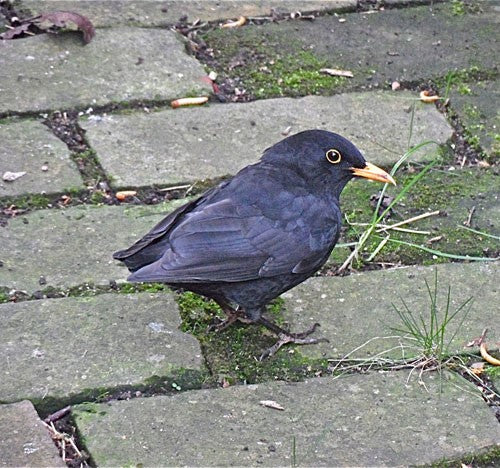
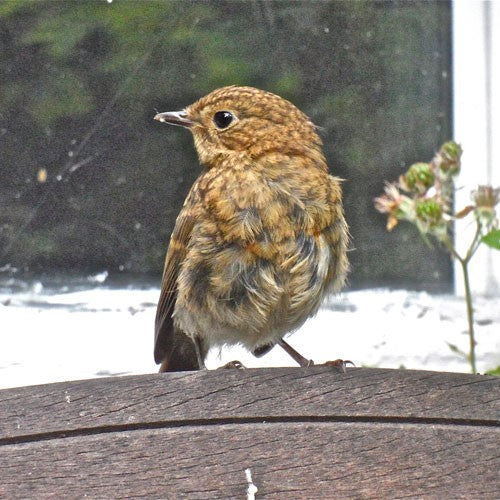
BILL ODDIE. April 2014.
Written by Simon H. King
